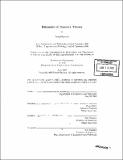| dc.contributor.advisor | Morris Halle and Alec Marantz. | en_US |
| dc.contributor.author | Harbour, Daniel, 1975- | en_US |
| dc.contributor.other | Massachusetts Institute of Technology. Dept. of Linguistics and Philosophy. | en_US |
| dc.date.accessioned | 2009-01-23T16:42:01Z | |
| dc.date.available | 2009-01-23T16:42:01Z | |
| dc.date.copyright | 2003 | en_US |
| dc.date.issued | 2003 | en_US |
| dc.identifier.uri | http://dspace.mit.edu/handle/1721.1/17581 | en_US |
| dc.identifier.uri | http://hdl.handle.net/1721.1/17581 | |
| dc.description | Thesis (Ph. D.)--Massachusetts Institute of Technology, Dept. of Linguistics and Philosophy, 2003. | en_US |
| dc.description | Includes bibliographical references (leaves 202-205). | en_US |
| dc.description.abstract | The dissertation argues for the necessity of a morphosemantic theory of number, that is, a theory of number serviceable both to semantics and morphology. The basis for this position, and the empirical core of the dissertation, is the relationship between semantically based noun classification and agreement in Kiowa, an indigenous, endangered language of Oklahoma. The central claim is that Universal Grammar provides three number features, concerned with unithood, existence of homogeneous subsets, and properties of those subsets. The features are used to analyze a wide variety of data. Semantic topics include the difference between granular and non-granular mass nouns, collective, non-collective and distributive plurals, and cardinality. Syntactic topics include the structure of DP, noun marking, agreement and suppletion. Morphological topics include the inventory of morphological operations, the featural basis of complex syncretisms, the difference between agreement and suppletion, whether features are privative or binary, and the nature of the Kiowa/Tanoan inverse. Keywords: Kiowa-Tanoan, number, morphology, semantics, agreement, suppletion, inverse, noun class, singular, dual, plural, features, binary, privative. | en_US |
| dc.description.statementofresponsibility | by Daniel Harbour. | en_US |
| dc.format.extent | 205 leaves | en_US |
| dc.language.iso | eng | en_US |
| dc.publisher | Massachusetts Institute of Technology | en_US |
| dc.rights | M.I.T. theses are protected by
copyright. They may be viewed from this source for any purpose, but
reproduction or distribution in any format is prohibited without written
permission. See provided URL for inquiries about permission. | en_US |
| dc.rights.uri | http://dspace.mit.edu/handle/1721.1/17581 | en_US |
| dc.rights.uri | http://dspace.mit.edu/handle/1721.1/7582 | en_US |
| dc.subject | Linguistics and Philosophy. | en_US |
| dc.title | Elements of number theory | en_US |
| dc.type | Thesis | en_US |
| dc.description.degree | Ph.D. | en_US |
| dc.contributor.department | Massachusetts Institute of Technology. Department of Linguistics and Philosophy | |
| dc.identifier.oclc | 53016325 | en_US |
